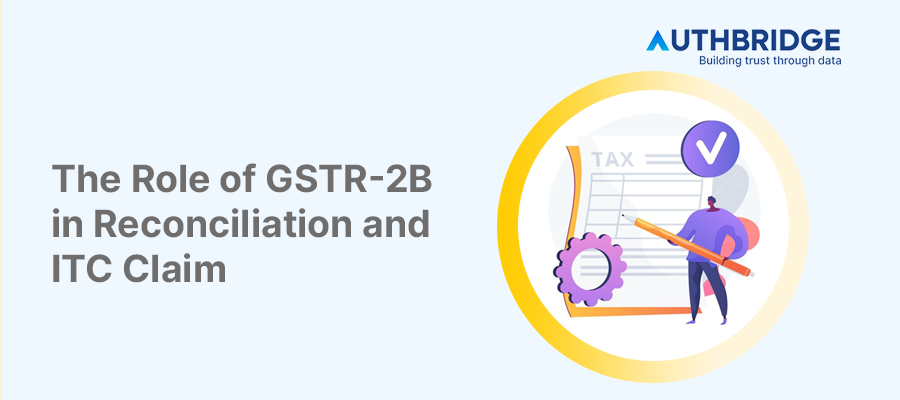The Role Of GSTR-2B In Accurate ITC Claims And Reconciliation

Overview of GSTR-2B
GSTR-2B is a static, auto-drafted ITC (Input Tax Credit) statement introduced on the GST portal for regular taxpayers, including those who have opted for the QRMP scheme. It provides a month-wise snapshot of eligible and ineligible ITC based on the GSTR-1, GSTR-5, and GSTR-6 filed by the suppliers. Unlike GSTR-2A, which is dynamic, GSTR-2B remains unchanged for a given period, ensuring stability in ITC claims.
The Launch and Availability of GSTR-2B
Launched from August 2020 tax period onwards, GSTR-2B aims to streamline the ITC claim process by providing a clear demarcation of eligible and ineligible credits. It is generated on the 12th day of the month following the tax period, offering taxpayers a reliable basis for claiming ITC in their GSTR-3B.
Importance and Benefits of GSTR-2B
Facilitating Accurate ITC Claims
GSTR-2B significantly aids taxpayers in claiming accurate Input Tax Credit (ITC) by providing a clear distinction between eligible and ineligible credits. This distinction helps in ensuring compliance with the GST law, as it prevents the claim of ITC on ineligible expenses and highlights the credits that need to be reversed as per the regulations.
Simplifying Reconciliation Process
The static nature of GSTR-2B simplifies the reconciliation process for taxpayers. Since the data in GSTR-2B does not change with subsequent supplier filings, it provides a stable reference point for reconciling ITC claims with purchase records. This stability is crucial for accurate monthly tax filings and reduces the chances of discrepancies that could lead to tax notices.
Accessing and Utilizing GSTR-2B
Steps to Access GSTR-2B
- Log in to the GST portal using your credentials.
- Navigate to the ‘Returns Dashboard’ and select the relevant tax period.
- Click on ‘View’ or ‘Download’ under the GSTR-2B tile, depending on your need.
Viewing and Downloading Options
- Download: If the document count exceeds 1,000, you can download the data in Excel/JSON format for detailed analysis.
- View: For fewer items, directly viewing the summary and detailed tables on the portal is more convenient.
Contents and Features of GSTR-2B
Summary Statement and Advisory
GSTR-2B includes a summary statement that categorizes ITC into 'available' and 'not available', accompanied by advisories for each section. These advisories guide taxpayers on the appropriate actions to be taken in their GSTR-3B filings.
Document-wise Details and Amendments
It provides document-wise details of ITC, including invoices and credit/debit notes, along with amendments. This level of detail supports thorough verification and reconciliation of ITC claims.
GSTR-2B vs GSTR-2A: A Comparative Analysis
Key Differences
- Nature: GSTR-2A is dynamic, changing with supplier filings, whereas GSTR-2B is static.
- Frequency: Both are monthly statements, but GSTR-2B offers a fixed snapshot for the tax period.
Impact on Taxpayers
The static nature of GSTR-2B provides certainty in ITC claims, reducing the need for constant monitoring of changes, unlike with GSTR-2A.
Reconciliation of GSTR-2B with Purchase Books
Importance of Matching GSTR-2B with Purchase Register
Reconciling GSTR-2B with the purchase register ensures that ITC claims are accurate and substantiated by actual purchases. This reconciliation is crucial for compliance and optimizing ITC claims.
Steps for Effective Reconciliation
- Match document-wise details from GSTR-2B against the purchase register.
- Identify discrepancies and follow up with suppliers for any missing or incorrect filings.
- Adjust ITC claims in GSTR-3B based on the reconciliation outcome.
Challenges in Reconciliation and ITC Claim
Common Mismatches and Their Resolutions
Discrepancies may arise due to differences in reporting periods, unaccounted debit/credit notes, or amendments by suppliers. Addressing these requires diligent communication with suppliers and adjustments in subsequent filings.
Tips for Efficient Reconciliation
- Regularly update and maintain purchase records.
- Use reconciliation tools for matching large volumes of data.
- Stay updated on GST regulations affecting ITC eligibility.
How Technology Aids in Reconciliation and Maximizing ITC
Tools for Reconciliation
Advanced GST software tools facilitate the reconciliation process by automating the comparison between GSTR-2B and purchase records. These tools can handle large data volumes, identify mismatches, and suggest corrective actions.
Features of Advanced Reconciliation Tools
- Bulk data handling: Manage thousands of entries efficiently.
- Mismatch identification: Highlight discrepancies for action.
- ITC optimization: Suggest ways to maximize eligible ITC claims.
Conclusion
GSTR-2B plays a pivotal role in the GST compliance framework by simplifying the ITC claim process. Its introduction has brought clarity and stability to the reconciliation process, aiding taxpayers in making accurate ITC claims. By leveraging technology and adhering to best practices for reconciliation, businesses can ensure compliance and optimize their ITC benefits. As the GST landscape evolves, staying informed and utilizing available tools will be key to navigating the complexities of ITC claims and reconciliation.
Category

Abhinandan Banerjee
(Associate Manager - Marketing)
Abhinandan is a dynamic Product and Content Marketer, boasting over seven years of experience in crafting impactful marketing strategies across diverse environments. Known for his strategic insights, he propels digital growth and boosts brand visibility by transforming complex ideas into compelling content that inspires action.



